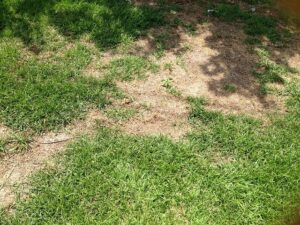Spring is a stunning time of year for your garden. Winter is left behind as the days lengthen and the weather warms. For Australian lawns, most of which are “warm-season” rather than “cool season”, this is perhaps the most critical moment of the year.
Spring is an incredibly important time for warm season grasses as most will essentially shut down over winter, falling into a state of dormancy. This halts growth, as the plant conserves its energy until it gets enough sun to grow again. Warm season grasses love sunlight and heat, so the further into spring the year goes, the more active and healthy your lawn will become.
With all this in mind, what potential issues might your warm season lawn face in spring? And how can you remedy them?

Soil Compaction
If your area is prone to heavy winter rains, soil compaction may be the most pressing issue your lawn faces in spring. Water forces the air from the soil, allowing it to settle and compact. This can result in your lawn’s roots being deprived of oxygen, browning areas off.
Aeration is best left to when the weather becomes warmer and the soil begins to dry. You can either use a garden fork (for small areas) or a rolling aerator (for large areas). Rolling aerators that take out soil plugs are best, as aerators that simply divide the soil can serve to compact it further either side of the spike.
Invasive Weeds
Just as your warm season lawn will enjoy the sunnier and hotter weather, so too will a whole host of weeds. Pre-emergent herbicides are a great option for this time of year, as they can be sown over your existing lawn to prevent any weeds from emerging.
It needs to be remembered, however, that these pre-emergent herbicides will also stop any new grass growth from forming. If your grass is looking a little tired after a long winter, it may be best to manually pick out any weeds that crop up.
Bare Spots
There are a range of reasons why your lawn could have bare spots in spring. It could be that the bald part of your lawn has been in shadow for much of the winter, and will get better as the sun sits higher in the sky. Perhaps it’s an issue of soil compaction.
Whatever the case, a bare patch on your lawn can be addressed quite quickly in spring, as your warm season lawn nears its peak growth period. Barrier off the patch, then overseed it with the recommended amount of seed. By the end of spring it should be fully recovered.

Infertile Soil
While not exactly a spring specific issue, this is one of the best times of year to address any concerns about the fertility of your soil. As the weather warms (if you’re in a frost-prone area, wait a couple of weeks after the last frost), sow a slow release, nitrogen heavy fertiliser over your lawn.
By the time your lawn begins to grow at its peak during late spring, your soil will be incredibly fertile and ready to handle the intense growth of the period.
Thatch Build-up
Thatch is the build-up of stems and roots that remain undecomposed. While a little bit of thatch is healthy for most lawns (0.5 – 1cm or so sitting at the base of the grass blade), anything larger than that can begin to suffocate your turf.
While cool-season grasses do well with a solid amount of thatch (it serves to insulate the plant from the cold), warm season lawns, particularly those in the parts of Australia that are prone to long periods of hot weather, can be severely affected by thatch build-up. Mow your grass down to 3 – 5cm, then use a rake to remove the built up thatch from the grass.
Your warm season grass is looking forward to the warmth of spring just as much as you. That’s why you should be doing all that you can to ensure your turf is now ready to make the most of this fine season, and is prepared to take on the heat of the Australian summer that follows.
 Free Metro Shipping, orders over $75
Free Metro Shipping, orders over $75

